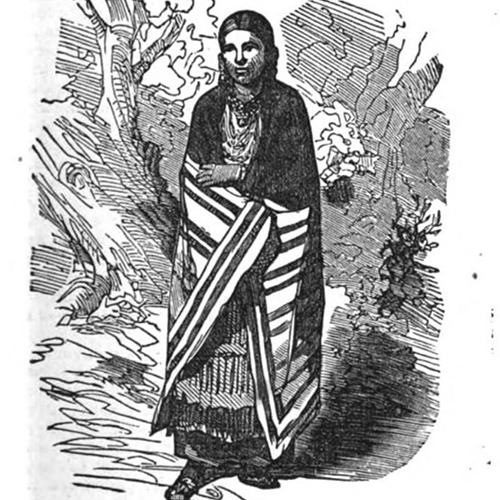Weetamoo (c. 1635-1676) was sachem of the Pocasset Wampanoag tribe of what is today Tiverton, Rhode Island. She sided with Metacom to fight the English in 1675 in “Metacom’s Rebellion,” or King Philip’s War. In 1990, the Town of Tiverton named Weetamoo Woods, a 750 acre preserve, in her honor.
Weetamoo (c. 1635-1676) was sachem of the Pocasset Wampanoag tribe of what is today Tiverton, Rhode Island. She sided with Metacom to fight the English in 1675 in “Metacom’s Rebellion,” or King Philip’s War.
Weetamoo was a Wampanoag woman. She lived in a time when Native American populations had been devastated by European disease, to which they had no immunity, and burgeoning populations of English colonists increasingly clashed with Natives over land, resources, and ways of life. Indigenous ways of knowing were passed on orally by the Wampanoag; much of what is presented here focuses primarily on the written records from these times which exclusively project the English colonial viewpoint. Given, also, the English inclination of the time to focus history on male-based institutions and events, the facts surrounding Weetamoo’s life are remote and equivocal. Nevertheless, an outline of Weetamoo’s life emerges across centuries of time, a testimony to the importance and strength of character of this woman.
Weetamoo was born about 1635 in the village of Pokanoket, now Rhode Island’s Taunton River area. In the Algonquian language Weetamoo’s name means “speak to them.” Her grandfather, Massasoit, or Ousamequin (Yellow Feather), was a great Wampanoag sachem who is said to have participated in the first Thanksgiving at Plymouth. Her father, Corbitant, was also a Chief, and Weetamoo inherited the position of sunksqua, or female sachem. Her band, the Pocassets, seasonally occupied contemporary Tiverton, RI.
Her life is variously portrayed, all speculative in detail, but all representing her as deeply committed to her tribe and its values and traditions. She was known for her love of nature and as a skilled bead worker and designer of artistic bead- and shellwork. She was beautiful and admired as a dancer. She is said to have had five husbands; she left one of her husbands, Petonowit, because he sided with the English, prioritizing her leadership role.
By the 1670s the strained peace between colonists and Wampanoags broke down chaotically. Standing against the colonists was a risk that many Native Americans were willing to choose to preserve their community and territory. Weetamoo joined with her brother-in-law Metacom in 1675 in “Metacom’s Rebellion,” or King Philip’s War, to fight the English. In 1676 the English prevailed and Weetamoo died in the conflict; she was 41 years old. The outcome of the war saw Natives dispossessed of their traditional homelands and many sold as slaves to Caribbean plantations regardless of their allegiance during the war.
Weetamoo Woods, over 750 acres of preserve established in 1990 by the Town of Tiverton, is an appropriate tribute in scale and dedication to this remarkable woman.
Arthur G. Gaines
reviewed by Tomaquag Museum staff
edited by Cathy Saunders
To read about Awashonks, sachem of the Sakonnets, and her role in King Philip’s War, visit her profile here.
Information from
-
Frost, John. “19th-century Drawing of Weetamoo.” World History Encyclopedia. World History Encyclopedia, 25 Mar. 2021. Originally published in Frost’s Pictorial History of Indian Wars and Captivities. Wells, 1873.
-
Smith, Patricia Clark. Weetamoo: Heart of the Pocassets, Massachusetts – Rhode Island, 1653. Scholastic, 2003.
-
Tiverton Open Space Commission. Weetamoo Woods – Pardon Gray Preserve. Information Sheet and Map. Tiverton, RI.
-
Tomaquag Museum, https://www.tomaquagmuseum.org/.
-
Wikipedia contributors. “Weetamoo.” Wikipedia, The Free Encyclopedia, 30 Oct. 2023, https://en.wikipedia.org/w/index.php?title=Weetamoo&oldid=1182633088.





